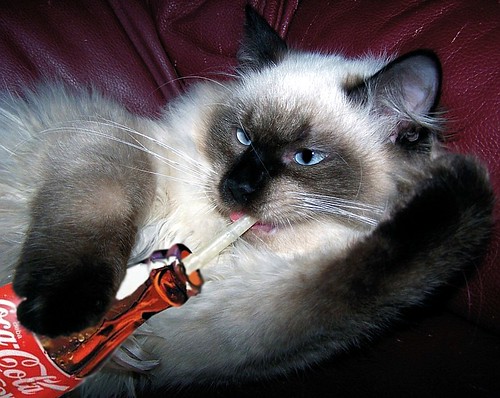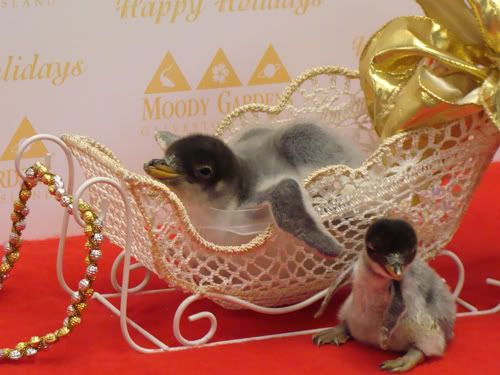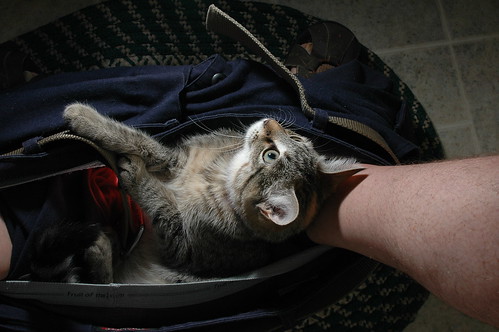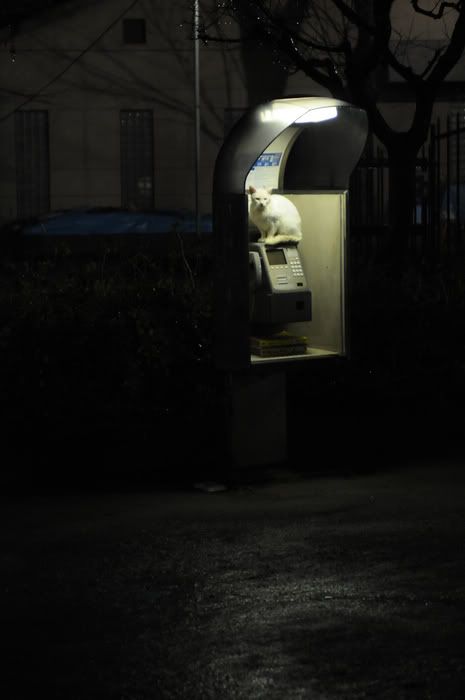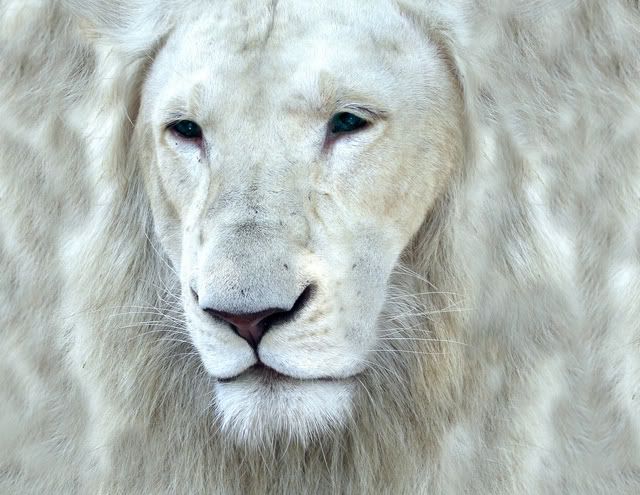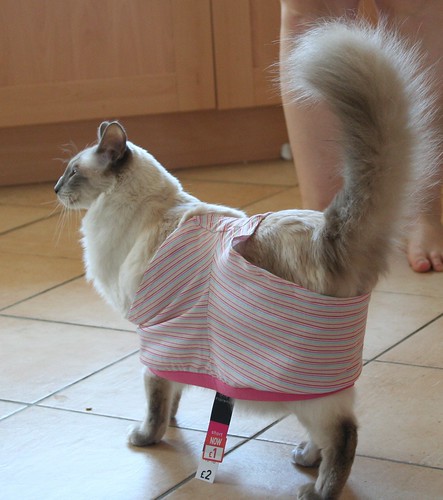|
|
|
|||||
|---|---|---|---|---|---|---|
|
|
|
Saturday, January 31, 2009
Video: Starlings' spectacular show
A flight of 20,000 starlings has been performing a spectacular aerial display at a Wetland Centre in Gloucestershire.
Watch video
(via Cronaca)
Watch video
(via Cronaca)
Video: Starlings' spectacular show
A flight of 20,000 starlings has been performing a spectacular aerial display at a Wetland Centre in Gloucestershire.
Watch video
(via Cronaca)
Watch video
(via Cronaca)
Friday, January 30, 2009
Thursday, January 29, 2009
Wednesday, January 28, 2009
Tuesday, January 27, 2009
Sex pheronome will be used on vampire fish
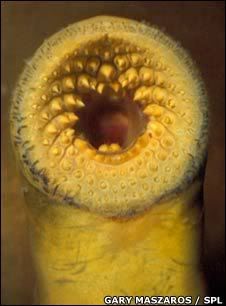 A synthetic "chemical sex smell" could help rid North America's Great Lakes of a devastating pest, scientists say.
A synthetic "chemical sex smell" could help rid North America's Great Lakes of a devastating pest, scientists say.US researchers deployed a laboratory version of a male sea lamprey pheromone to trick ovulating females into swimming upstream into traps.
The sea lamprey, sometimes dubbed the "vampire fish", has parasitised native species of the Great Lakes since its accidental introduction in the 1800s.
The sea lamprey's natural life cycle takes it from birth in a stream to adulthood in the ocean, where it gains its vampirical appellation.
Circular jaws lock on to another, larger fish, and a sharp tongue carves through its scales.
From then on the lamprey feeds on the blood and body fluids of its temporary host, often killing it in the process.
Eventually, the satiated lampreys - both males and females - find a suitable stream to swim up, breed and die.
Unlike salmon, which seek out the stream they were born in, lampreys appear willing to take any stream indicating a suitable breeding place; and perhaps pheromones play a role in identifying streams worth selecting.
Source: BBC
Labels:
animals,
environment,
fish
Sex pheronome will be used on vampire fish
 A synthetic "chemical sex smell" could help rid North America's Great Lakes of a devastating pest, scientists say.
A synthetic "chemical sex smell" could help rid North America's Great Lakes of a devastating pest, scientists say.US researchers deployed a laboratory version of a male sea lamprey pheromone to trick ovulating females into swimming upstream into traps.
The sea lamprey, sometimes dubbed the "vampire fish", has parasitised native species of the Great Lakes since its accidental introduction in the 1800s.
The sea lamprey's natural life cycle takes it from birth in a stream to adulthood in the ocean, where it gains its vampirical appellation.
Circular jaws lock on to another, larger fish, and a sharp tongue carves through its scales.
From then on the lamprey feeds on the blood and body fluids of its temporary host, often killing it in the process.
Eventually, the satiated lampreys - both males and females - find a suitable stream to swim up, breed and die.
Unlike salmon, which seek out the stream they were born in, lampreys appear willing to take any stream indicating a suitable breeding place; and perhaps pheromones play a role in identifying streams worth selecting.
Source: BBC
Labels:
animals,
environment,
fish
Monday, January 26, 2009
Frog populations not helped by dinner menus
About one-third of all amphibians are listed as threatened species, with habitat loss the biggest factor.
But hunting is acknowledged as another important driver for some species, along with climate change, pollution and disease - notably the fungal condition chytridiomycosis which has brought rapid extinctions to some amphibians.
"Frogs legs are on the menu at school cafeterias in Europe, market stalls and dinner tables across Asia to high end restaurants throughout the world," said Corey Bradshaw from Adelaide University in Australia.
"Amphibians are already the most threatened animal group yet assessed because of disease, habitat loss and climate change - man's massive appetite for their legs is not helping."
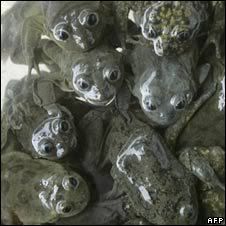 Frogs are liquidised to make a "health drink" in parts of South America.
Frogs are liquidised to make a "health drink" in parts of South America.
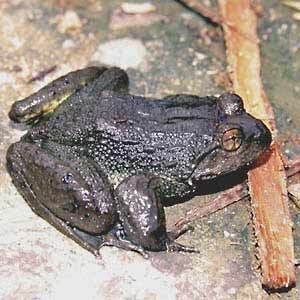 Frogs of the stream-dwelling Paa genus are among the most popular for hunting in China. But numbers in some areas have fallen 10-fold as a result of over-exploitation.
Frogs of the stream-dwelling Paa genus are among the most popular for hunting in China. But numbers in some areas have fallen 10-fold as a result of over-exploitation.
These frogs could be candidates for sustainable harvesting plans, where hunting is allowed but controlled. Image: Kadoorie Farm & Botanic Garden – KFBG
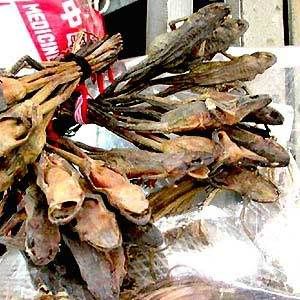 Rana chensinensis is declining steeply in some areas; a study in Heilongjiang found that the annual catch fell by 99% between 1971 and 1986. The main reason is traditional medicine.
Rana chensinensis is declining steeply in some areas; a study in Heilongjiang found that the annual catch fell by 99% between 1971 and 1986. The main reason is traditional medicine.
Oil made from the female frog's oviduct is believed to be a tonic to the kidneys and lungs, and to cure respiratory ailments. Image: KFBG
 Frogs and toads are also sold as tonics in the markets of Peru.
Frogs and toads are also sold as tonics in the markets of Peru.
This stallholder in Cuzco sells "Extracto de Rana", a drink made from the extract of two to three frogs, which is blended with honey, malt and other ingredients.
Other recipes call for 30 frogs in a single drink. Image: Esteban Lavilla
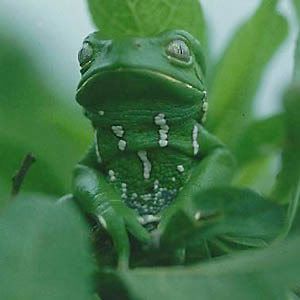 In western Brazil and eastern Peru, frogs of the Phyllomedusa genus are used as a hallucinogen.
In western Brazil and eastern Peru, frogs of the Phyllomedusa genus are used as a hallucinogen.
Chemicals secreted by the frog's skin and introduced into a human's bloodstream are said to lead initially to vomiting and incontinence, then deep sleep, and finally a period of enhanced sensitivity in sight and hearing. Image: E. Lavilla
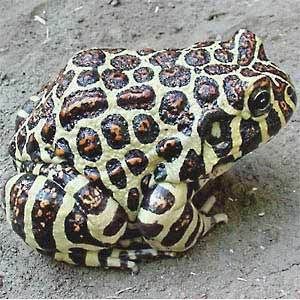 Leptodactylus laticeps is exported from South America to the developed world. It can fetch prices of 600 euros in European pet shops.
Leptodactylus laticeps is exported from South America to the developed world. It can fetch prices of 600 euros in European pet shops.
In some areas where it lives, in Argentina, Bolivia and Paraguay, people earn as little as 1,200 euros in a single year, giving them a real incentive to catch and sell it. Image: E. Lavilla
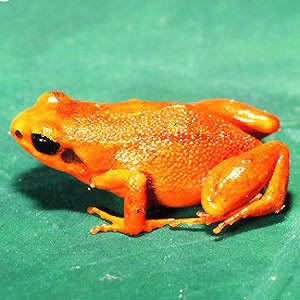 Mantellas are among the most popular frogs as pets. The principal source is Madagascar, from where many amphibians are exported into the pet trade.
Mantellas are among the most popular frogs as pets. The principal source is Madagascar, from where many amphibians are exported into the pet trade.
This species, the black-eared mantella (Mantella milotympanum), is critically endangered. Habitat loss is also a major threat. Image: Franco Andreone/ARKive
Source: BBC
But hunting is acknowledged as another important driver for some species, along with climate change, pollution and disease - notably the fungal condition chytridiomycosis which has brought rapid extinctions to some amphibians.
"Frogs legs are on the menu at school cafeterias in Europe, market stalls and dinner tables across Asia to high end restaurants throughout the world," said Corey Bradshaw from Adelaide University in Australia.
"Amphibians are already the most threatened animal group yet assessed because of disease, habitat loss and climate change - man's massive appetite for their legs is not helping."
 Frogs are liquidised to make a "health drink" in parts of South America.
Frogs are liquidised to make a "health drink" in parts of South America. Frogs of the stream-dwelling Paa genus are among the most popular for hunting in China. But numbers in some areas have fallen 10-fold as a result of over-exploitation.
Frogs of the stream-dwelling Paa genus are among the most popular for hunting in China. But numbers in some areas have fallen 10-fold as a result of over-exploitation.These frogs could be candidates for sustainable harvesting plans, where hunting is allowed but controlled. Image: Kadoorie Farm & Botanic Garden – KFBG
 Rana chensinensis is declining steeply in some areas; a study in Heilongjiang found that the annual catch fell by 99% between 1971 and 1986. The main reason is traditional medicine.
Rana chensinensis is declining steeply in some areas; a study in Heilongjiang found that the annual catch fell by 99% between 1971 and 1986. The main reason is traditional medicine.Oil made from the female frog's oviduct is believed to be a tonic to the kidneys and lungs, and to cure respiratory ailments. Image: KFBG
 Frogs and toads are also sold as tonics in the markets of Peru.
Frogs and toads are also sold as tonics in the markets of Peru.This stallholder in Cuzco sells "Extracto de Rana", a drink made from the extract of two to three frogs, which is blended with honey, malt and other ingredients.
Other recipes call for 30 frogs in a single drink. Image: Esteban Lavilla
 In western Brazil and eastern Peru, frogs of the Phyllomedusa genus are used as a hallucinogen.
In western Brazil and eastern Peru, frogs of the Phyllomedusa genus are used as a hallucinogen.Chemicals secreted by the frog's skin and introduced into a human's bloodstream are said to lead initially to vomiting and incontinence, then deep sleep, and finally a period of enhanced sensitivity in sight and hearing. Image: E. Lavilla
 Leptodactylus laticeps is exported from South America to the developed world. It can fetch prices of 600 euros in European pet shops.
Leptodactylus laticeps is exported from South America to the developed world. It can fetch prices of 600 euros in European pet shops.In some areas where it lives, in Argentina, Bolivia and Paraguay, people earn as little as 1,200 euros in a single year, giving them a real incentive to catch and sell it. Image: E. Lavilla
 Mantellas are among the most popular frogs as pets. The principal source is Madagascar, from where many amphibians are exported into the pet trade.
Mantellas are among the most popular frogs as pets. The principal source is Madagascar, from where many amphibians are exported into the pet trade.This species, the black-eared mantella (Mantella milotympanum), is critically endangered. Habitat loss is also a major threat. Image: Franco Andreone/ARKive
Source: BBC
Labels:
amphibians,
animals,
food,
frogs
Frog populations not helped by dinner menus
About one-third of all amphibians are listed as threatened species, with habitat loss the biggest factor.
But hunting is acknowledged as another important driver for some species, along with climate change, pollution and disease - notably the fungal condition chytridiomycosis which has brought rapid extinctions to some amphibians.
"Frogs legs are on the menu at school cafeterias in Europe, market stalls and dinner tables across Asia to high end restaurants throughout the world," said Corey Bradshaw from Adelaide University in Australia.
"Amphibians are already the most threatened animal group yet assessed because of disease, habitat loss and climate change - man's massive appetite for their legs is not helping."
 Frogs are liquidised to make a "health drink" in parts of South America.
Frogs are liquidised to make a "health drink" in parts of South America.
 Frogs of the stream-dwelling Paa genus are among the most popular for hunting in China. But numbers in some areas have fallen 10-fold as a result of over-exploitation.
Frogs of the stream-dwelling Paa genus are among the most popular for hunting in China. But numbers in some areas have fallen 10-fold as a result of over-exploitation.
These frogs could be candidates for sustainable harvesting plans, where hunting is allowed but controlled. Image: Kadoorie Farm & Botanic Garden – KFBG
 Rana chensinensis is declining steeply in some areas; a study in Heilongjiang found that the annual catch fell by 99% between 1971 and 1986. The main reason is traditional medicine.
Rana chensinensis is declining steeply in some areas; a study in Heilongjiang found that the annual catch fell by 99% between 1971 and 1986. The main reason is traditional medicine.
Oil made from the female frog's oviduct is believed to be a tonic to the kidneys and lungs, and to cure respiratory ailments. Image: KFBG
 Frogs and toads are also sold as tonics in the markets of Peru.
Frogs and toads are also sold as tonics in the markets of Peru.
This stallholder in Cuzco sells "Extracto de Rana", a drink made from the extract of two to three frogs, which is blended with honey, malt and other ingredients.
Other recipes call for 30 frogs in a single drink. Image: Esteban Lavilla
 In western Brazil and eastern Peru, frogs of the Phyllomedusa genus are used as a hallucinogen.
In western Brazil and eastern Peru, frogs of the Phyllomedusa genus are used as a hallucinogen.
Chemicals secreted by the frog's skin and introduced into a human's bloodstream are said to lead initially to vomiting and incontinence, then deep sleep, and finally a period of enhanced sensitivity in sight and hearing. Image: E. Lavilla
 Leptodactylus laticeps is exported from South America to the developed world. It can fetch prices of 600 euros in European pet shops.
Leptodactylus laticeps is exported from South America to the developed world. It can fetch prices of 600 euros in European pet shops.
In some areas where it lives, in Argentina, Bolivia and Paraguay, people earn as little as 1,200 euros in a single year, giving them a real incentive to catch and sell it. Image: E. Lavilla
 Mantellas are among the most popular frogs as pets. The principal source is Madagascar, from where many amphibians are exported into the pet trade.
Mantellas are among the most popular frogs as pets. The principal source is Madagascar, from where many amphibians are exported into the pet trade.
This species, the black-eared mantella (Mantella milotympanum), is critically endangered. Habitat loss is also a major threat. Image: Franco Andreone/ARKive
Source: BBC
But hunting is acknowledged as another important driver for some species, along with climate change, pollution and disease - notably the fungal condition chytridiomycosis which has brought rapid extinctions to some amphibians.
"Frogs legs are on the menu at school cafeterias in Europe, market stalls and dinner tables across Asia to high end restaurants throughout the world," said Corey Bradshaw from Adelaide University in Australia.
"Amphibians are already the most threatened animal group yet assessed because of disease, habitat loss and climate change - man's massive appetite for their legs is not helping."
 Frogs are liquidised to make a "health drink" in parts of South America.
Frogs are liquidised to make a "health drink" in parts of South America. Frogs of the stream-dwelling Paa genus are among the most popular for hunting in China. But numbers in some areas have fallen 10-fold as a result of over-exploitation.
Frogs of the stream-dwelling Paa genus are among the most popular for hunting in China. But numbers in some areas have fallen 10-fold as a result of over-exploitation.These frogs could be candidates for sustainable harvesting plans, where hunting is allowed but controlled. Image: Kadoorie Farm & Botanic Garden – KFBG
 Rana chensinensis is declining steeply in some areas; a study in Heilongjiang found that the annual catch fell by 99% between 1971 and 1986. The main reason is traditional medicine.
Rana chensinensis is declining steeply in some areas; a study in Heilongjiang found that the annual catch fell by 99% between 1971 and 1986. The main reason is traditional medicine.Oil made from the female frog's oviduct is believed to be a tonic to the kidneys and lungs, and to cure respiratory ailments. Image: KFBG
 Frogs and toads are also sold as tonics in the markets of Peru.
Frogs and toads are also sold as tonics in the markets of Peru.This stallholder in Cuzco sells "Extracto de Rana", a drink made from the extract of two to three frogs, which is blended with honey, malt and other ingredients.
Other recipes call for 30 frogs in a single drink. Image: Esteban Lavilla
 In western Brazil and eastern Peru, frogs of the Phyllomedusa genus are used as a hallucinogen.
In western Brazil and eastern Peru, frogs of the Phyllomedusa genus are used as a hallucinogen.Chemicals secreted by the frog's skin and introduced into a human's bloodstream are said to lead initially to vomiting and incontinence, then deep sleep, and finally a period of enhanced sensitivity in sight and hearing. Image: E. Lavilla
 Leptodactylus laticeps is exported from South America to the developed world. It can fetch prices of 600 euros in European pet shops.
Leptodactylus laticeps is exported from South America to the developed world. It can fetch prices of 600 euros in European pet shops.In some areas where it lives, in Argentina, Bolivia and Paraguay, people earn as little as 1,200 euros in a single year, giving them a real incentive to catch and sell it. Image: E. Lavilla
 Mantellas are among the most popular frogs as pets. The principal source is Madagascar, from where many amphibians are exported into the pet trade.
Mantellas are among the most popular frogs as pets. The principal source is Madagascar, from where many amphibians are exported into the pet trade.This species, the black-eared mantella (Mantella milotympanum), is critically endangered. Habitat loss is also a major threat. Image: Franco Andreone/ARKive
Source: BBC
Labels:
amphibians,
animals,
food,
frogs
Cute or not? Honduran White Bat
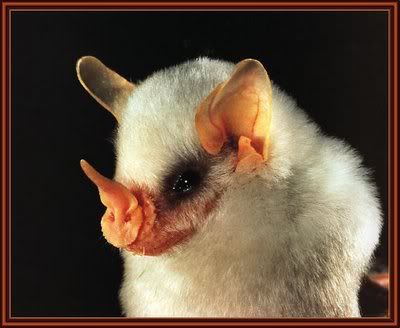 Photo found at The Wonderful World of Animals
Photo found at The Wonderful World of Animals
Labels:
animals,
bats,
cute or not
Cute or not? Honduran White Bat
 Photo found at The Wonderful World of Animals
Photo found at The Wonderful World of Animals
Labels:
animals,
bats,
cute or not
Sunday, January 25, 2009
Look, a necktie for your dog
 Your pet will look irresistible wearing this charming accessory, let others know that if they get too close, prepare to get a little wet! Elastic loop fits your pet comfortably. Embroidered, machine-washable polyester, 6 x 2".
Your pet will look irresistible wearing this charming accessory, let others know that if they get too close, prepare to get a little wet! Elastic loop fits your pet comfortably. Embroidered, machine-washable polyester, 6 x 2".$7.98 at Taylor Gifts
Labels:
animals,
dogs,
merchandise
Look, a necktie for your dog
 Your pet will look irresistible wearing this charming accessory, let others know that if they get too close, prepare to get a little wet! Elastic loop fits your pet comfortably. Embroidered, machine-washable polyester, 6 x 2".
Your pet will look irresistible wearing this charming accessory, let others know that if they get too close, prepare to get a little wet! Elastic loop fits your pet comfortably. Embroidered, machine-washable polyester, 6 x 2".$7.98 at Taylor Gifts
Labels:
animals,
dogs,
merchandise
Saturday, January 24, 2009
Friday, January 23, 2009
How old is that in dog years?
This puppy was photographed in 1845, which would make it 164 years old.
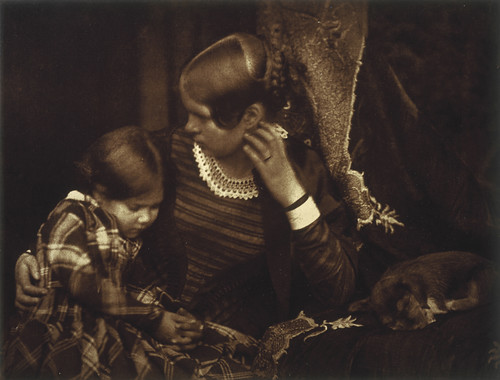 The photo, "Harriet Farnie and Miss Farnie with a Sleeping Puppy, Brownie" is from the National Galleries of Scotland's photostream, now available on Flickr.
The photo, "Harriet Farnie and Miss Farnie with a Sleeping Puppy, Brownie" is from the National Galleries of Scotland's photostream, now available on Flickr.
Robert Adamson, David Octavius Hill
1920 (original negative around 1845)
Accession no. PGP HA 390
Medium Carbon print
Size 15.40 x 20.20 cm
Credit Elliot Collection, bequeathed 1950
 The photo, "Harriet Farnie and Miss Farnie with a Sleeping Puppy, Brownie" is from the National Galleries of Scotland's photostream, now available on Flickr.
The photo, "Harriet Farnie and Miss Farnie with a Sleeping Puppy, Brownie" is from the National Galleries of Scotland's photostream, now available on Flickr.Robert Adamson, David Octavius Hill
1920 (original negative around 1845)
Accession no. PGP HA 390
Medium Carbon print
Size 15.40 x 20.20 cm
Credit Elliot Collection, bequeathed 1950
Labels:
animals,
dog,
history,
photography,
puppy
How old is that in dog years?
This puppy was photographed in 1845, which would make it 164 years old.
 The photo, "Harriet Farnie and Miss Farnie with a Sleeping Puppy, Brownie" is from the National Galleries of Scotland's photostream, now available on Flickr.
The photo, "Harriet Farnie and Miss Farnie with a Sleeping Puppy, Brownie" is from the National Galleries of Scotland's photostream, now available on Flickr.
Robert Adamson, David Octavius Hill
1920 (original negative around 1845)
Accession no. PGP HA 390
Medium Carbon print
Size 15.40 x 20.20 cm
Credit Elliot Collection, bequeathed 1950
 The photo, "Harriet Farnie and Miss Farnie with a Sleeping Puppy, Brownie" is from the National Galleries of Scotland's photostream, now available on Flickr.
The photo, "Harriet Farnie and Miss Farnie with a Sleeping Puppy, Brownie" is from the National Galleries of Scotland's photostream, now available on Flickr.Robert Adamson, David Octavius Hill
1920 (original negative around 1845)
Accession no. PGP HA 390
Medium Carbon print
Size 15.40 x 20.20 cm
Credit Elliot Collection, bequeathed 1950
Labels:
animals,
dog,
history,
photography,
puppy
Ouch!
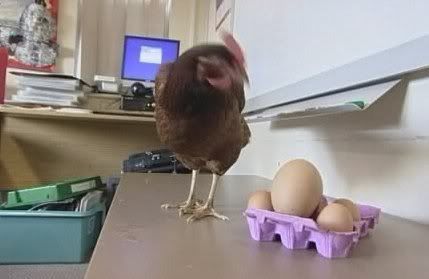 A chicken adopted by schoolchildren stunned the class by producing giant eggs nearly twice the normal size.
A chicken adopted by schoolchildren stunned the class by producing giant eggs nearly twice the normal size.Little Lil, being cared for by pupils the Raikes Centre, in Kingsholm, Gloucester, lays eggs measuring 4.3in (11cm) rather than the usual 2.4in (6cm).
Teacher Kate Farminer said pupils were astonished when the Columbian blacktail cross began producing "supersized" eggs weighing 7oz (200 grams). The average egg is around 2oz (60 grams).
Source: BBC
Ouch!
 A chicken adopted by schoolchildren stunned the class by producing giant eggs nearly twice the normal size.
A chicken adopted by schoolchildren stunned the class by producing giant eggs nearly twice the normal size.Little Lil, being cared for by pupils the Raikes Centre, in Kingsholm, Gloucester, lays eggs measuring 4.3in (11cm) rather than the usual 2.4in (6cm).
Teacher Kate Farminer said pupils were astonished when the Columbian blacktail cross began producing "supersized" eggs weighing 7oz (200 grams). The average egg is around 2oz (60 grams).
Source: BBC
Thursday, January 22, 2009
Way too cute!
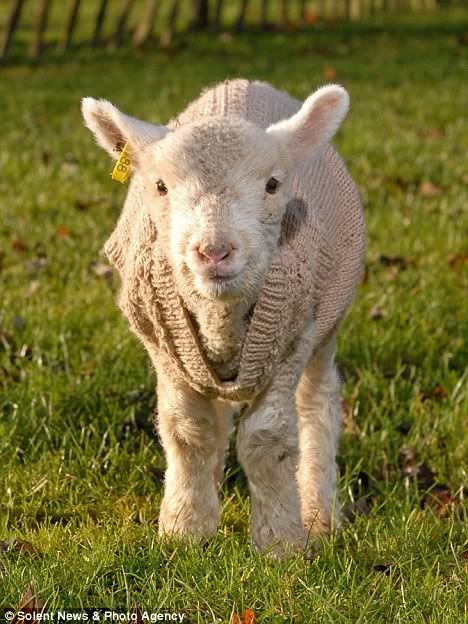 This tiny, orphaned lamb, who is one of twins, was rescued by volunteers at Manor Farm Country Park, near Southampton, Hampshire. Concerned about the risk of the tiny new born perishing in the cold weather, volunteers at the farm found him a knitted baby sweater to keep him warm.
This tiny, orphaned lamb, who is one of twins, was rescued by volunteers at Manor Farm Country Park, near Southampton, Hampshire. Concerned about the risk of the tiny new born perishing in the cold weather, volunteers at the farm found him a knitted baby sweater to keep him warm.Source: Daily Mail
Labels:
animals,
cute,
lambs,
white animals
Way too cute!
 This tiny, orphaned lamb, who is one of twins, was rescued by volunteers at Manor Farm Country Park, near Southampton, Hampshire. Concerned about the risk of the tiny new born perishing in the cold weather, volunteers at the farm found him a knitted baby sweater to keep him warm.
This tiny, orphaned lamb, who is one of twins, was rescued by volunteers at Manor Farm Country Park, near Southampton, Hampshire. Concerned about the risk of the tiny new born perishing in the cold weather, volunteers at the farm found him a knitted baby sweater to keep him warm.Source: Daily Mail
Labels:
animals,
cute,
lambs,
white animals
Frankie, the Walk 'N Roll Dog
 The story of Frankie, the Walk ‘N Roll Dog is a true, inspirational story about a dog whose life started out just like any other dog walking on all four paws until a spinal injury leaves her paralyzed. When Frankie is custom fit for a wheelchair she gradually learns to keep on rolling. Her zest for life will have you cheering her on and give you hope that all things are possible.
The story of Frankie, the Walk ‘N Roll Dog is a true, inspirational story about a dog whose life started out just like any other dog walking on all four paws until a spinal injury leaves her paralyzed. When Frankie is custom fit for a wheelchair she gradually learns to keep on rolling. Her zest for life will have you cheering her on and give you hope that all things are possible.On Frankie's website, there are more photos of Frankie and some insights into what her life is like.
Frankie, the Walk 'N Roll Dog
 The story of Frankie, the Walk ‘N Roll Dog is a true, inspirational story about a dog whose life started out just like any other dog walking on all four paws until a spinal injury leaves her paralyzed. When Frankie is custom fit for a wheelchair she gradually learns to keep on rolling. Her zest for life will have you cheering her on and give you hope that all things are possible.
The story of Frankie, the Walk ‘N Roll Dog is a true, inspirational story about a dog whose life started out just like any other dog walking on all four paws until a spinal injury leaves her paralyzed. When Frankie is custom fit for a wheelchair she gradually learns to keep on rolling. Her zest for life will have you cheering her on and give you hope that all things are possible.On Frankie's website, there are more photos of Frankie and some insights into what her life is like.
Wednesday, January 21, 2009
Rabbid Rabbits?

Don't they look yummy?
Found at Anna the Red's Bento Factory, where you can also find instructions for sushi and creative bento ideas.
Rabbid Rabbits?

Don't they look yummy?
Found at Anna the Red's Bento Factory, where you can also find instructions for sushi and creative bento ideas.
Tuesday, January 20, 2009
Time to appreciate penguins
January 20 is Penguin Awareness Day.
Why is today Penguin Awareness day? No one knows.
What's so special about this day? No one knows.
So - celebrate in your own way ...
 from Flickr, by ekpatterson
from Flickr, by ekpatterson
 from Flickr, by moria
from Flickr, by moria
 from Flickr, by rarewren
from Flickr, by rarewren
(via Penguins!)
Why is today Penguin Awareness day? No one knows.
What's so special about this day? No one knows.
So - celebrate in your own way ...
 from Flickr, by ekpatterson
from Flickr, by ekpatterson from Flickr, by moria
from Flickr, by moria from Flickr, by rarewren
from Flickr, by rarewren(via Penguins!)
Time to appreciate penguins
January 20 is Penguin Awareness Day.
Why is today Penguin Awareness day? No one knows.
What's so special about this day? No one knows.
So - celebrate in your own way ...
 from Flickr, by ekpatterson
from Flickr, by ekpatterson
 from Flickr, by moria
from Flickr, by moria
 from Flickr, by rarewren
from Flickr, by rarewren
(via Penguins!)
Why is today Penguin Awareness day? No one knows.
What's so special about this day? No one knows.
So - celebrate in your own way ...
 from Flickr, by ekpatterson
from Flickr, by ekpatterson from Flickr, by moria
from Flickr, by moria from Flickr, by rarewren
from Flickr, by rarewren(via Penguins!)
Subscribe to:
Posts (Atom)

